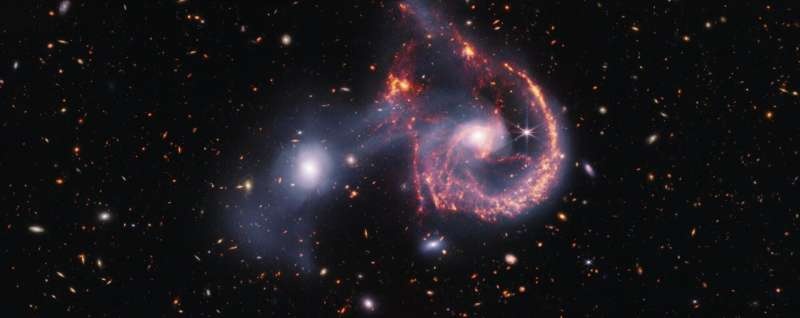The James Webb Space Telescope has provided an unprecedented view of the intriguing galaxy pair Arp 107, capturing the captivating interplay between an elliptical and a spiral galaxy. This cosmic collision offers a glimpse into the dynamic nature of galaxy interactions and their impact on star formation.

Celestial Lovers’ Embrace
The enchanting couple of galaxies Arp 107 has unveiled an even more spectacular image in the cosmos through the lens of the Webb Telescope. Elliptical galaxy and Spiral galaxy engage in a delicate dance, that leaves one of the galaxies looking much happier and more well-adjusted.
MIRI and NIRCam use infrared radiation, so the above image was an infrared observation, providing a wealth of detail that we previously lacked for this binary star system! The white network of stars and gas, strung between the two galaxies during their near-collision, forms a contrast to the jumble of thick dust lanes speckled with young blue stars in this image.
These observations not only illustrate the grace of galaxy collisions but also provide key information on much more difficult, complicated phenomena that mold the history of these immense objects. A more detailed analysis of these interactions, as well as the relationship between star-forming regions and the dust composition that is revealed by MIRI data, provides insight into how they may have had a widespread influence on when and where new stars are born in the Universe and where organic molecules are located.
Demystifying Seyfert Galaxies
What makes Arp 107 interesting is that the spiral of these galaxies is a Seyfert galaxy, an active galaxy characterized by a bright nucleus and the presence in its center of a supermassive black hole. Since the Seyfert galaxies are also less luminous and distant than quasars, they may be a more accessible subject for astronomers trying to understand the effects of active galactic nuclei.
The Webb Telescope’s views of the bright nucleus within Arp 107 offer an ideal window into just how such active galaxies operate. Research that helps astronomers learn about the processes powering these cosmic behemoths and the impact of these processes on their environment; scientists study the infrared light emitted from them to better understand the nature of nearby supermassive black holes.
In addition, the contrast between Arp 107 and the previously identified Cartwheel Galaxy demonstrates the unique variety present in galaxy collisions and variance due to slight differences in interaction circumstances. Though the off-center collision that created Arp 107 is far from the head-on approach of the Cartwheel Galaxy’s passage through another galaxy, it has delivered a more subdued but equally compelling makeover of two spiral galaxies.
Conclusion
Webb Telescope provides a glimpse of galactic danceNASA’s James Webb Space Telescope recently captured the social distancing observed among a pair of galaxy clusters and joined in — from an intergalactic perspective This cosmic waltz — the hug between an elliptical and a spiral galaxy can captivate us visually, but it also reveals vital information about how galaxies grow and evolve. From the knowledge gained on Seyfert galaxies to the finer distinctions between various types of galaxy interactions, this finding showcases the incredible strengths of the Webb Telescope and its prospects for demystifying more cosmic puzzles.
